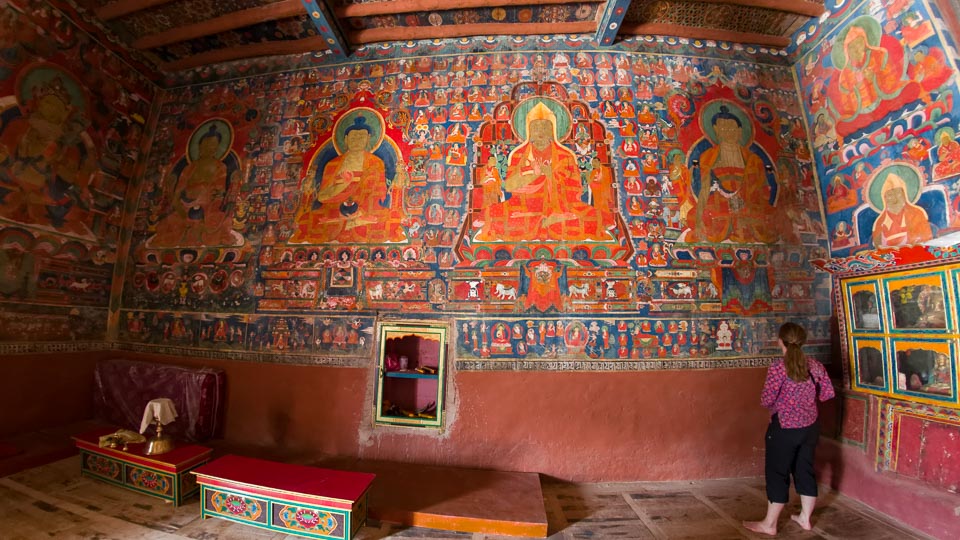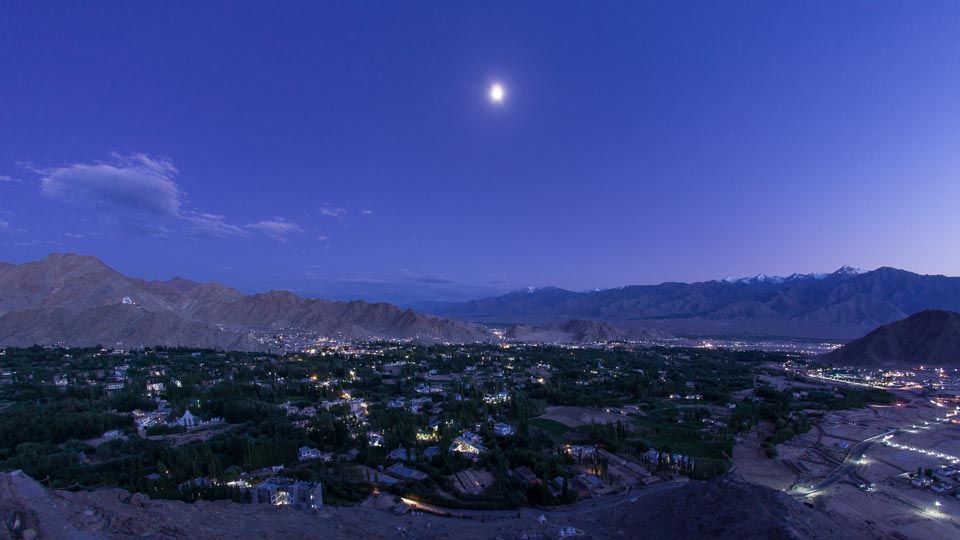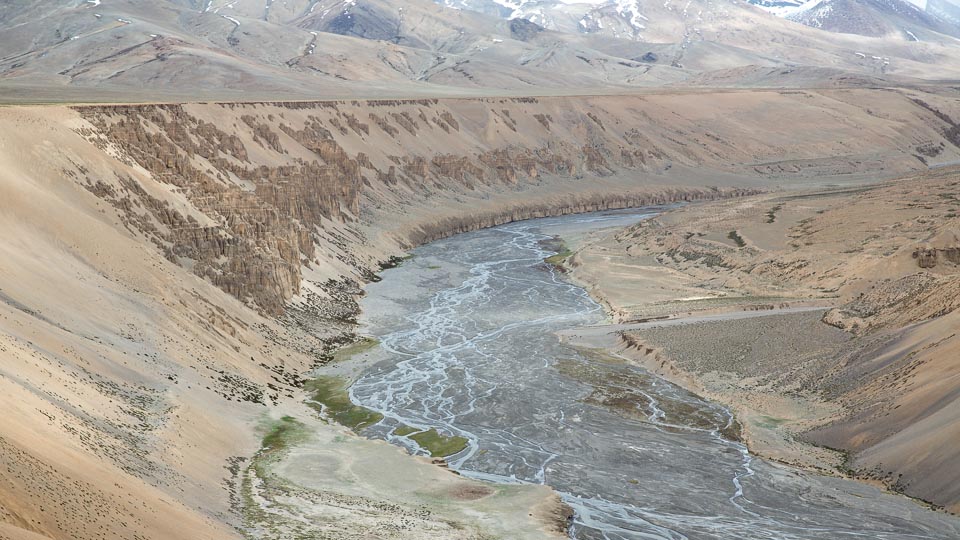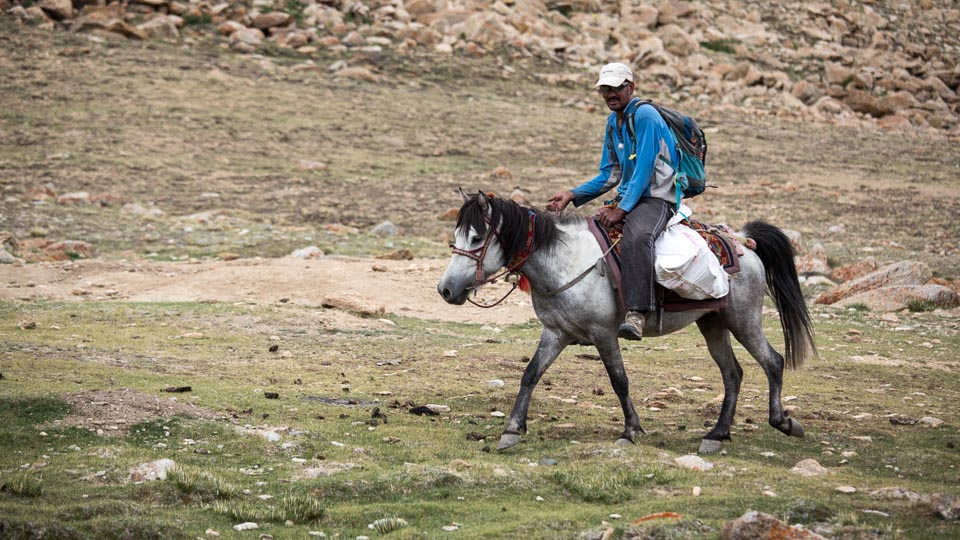Detailed itinerary
We plan to follow the itinerary however roads wash
out, or are extended, occasionally people get sick, logistical challenges arise,
or we hear of a better campsite, and so
we adapt as needed.
(Day 0 - arrive Delhi / early Leh arrival)
We spend three nights in Leh, so reasonable acclimatization to the
3480m/11,415ft altitude but if you are new
to altitude or to Leh, perhaps plan to arrive one day early and we will
arrange transfers and hotel and show you around.
Included in all our Ladakh trips are a couple of sightseeing trips, with or
without a cultural guide (your choice) and it is your choice of where to go;
many people joining are previous trekkers so have seen some places previously.
If you are more ambitious we can also help you arrange a day or overnight trip
to Alchi (~3100m) and Basgo Gompas or further afield Lamayuru (~3500m), a day rafting trip on the Zanskar River or or hammer down the Khardung La on a mountain bike (best a few days into your Leh
sojourn). If you have been working flat out you are welcome to just relax, kick
back and de-stress too, and adjust to the time zone change.

Sophie admires the mural at Basgo - Jamie
Day 1 - meet in Leh 3480m
Phew, after a long series of flights, you are here! Look for a Project Himalaya sign or a simple sign with your
name on it at the airport, and our wonderful drivers Lobsang or Ang Chuk will pick you up.
Jamie meets you at the hotel on your arrival and we discuss altitude health over
tea/coffee or breakfast and introduce Leh (if you are a first timer) and show you the better places
to eat. Most people crash out for a few hours and spend the day relaxing; do drink
plenty of fluids which helps the acclimatization process, perhaps pop some multi-vitamins and let your body adjust to the new time zone.
We normally go out to
dinner together, let's meet in the peaceful hotel garden at 6:30pm. We eat at some of our favourite clean (very important!) restaurants: Chopsticks, Tibet Kitchen, Summer Harvest and Wonderland.
2 - Leh 3480m
This is a day for sightseeing and relaxing. For today perhaps the best plan is to visit some of the world's most revered gompas and
monasteries a short distance from Leh. We will help plan and arrange a jeep, and a local
cultural guide if you like (included). Usually we arrange as a morning trip with lunch at Leh (or Thikse) then
you can relax in the afternoon although we can easily arrange a full day trip.
Choosing where to go is the biggest
challenge, there are so many special places to visit. To the east is Shey, Thikse, Hemis, Chemde, Thagthok, Stakna, Matho and Stok, although don't plan on visiting all of them in one day. Thikse also has a good restaurant for lunch.
Heading west out of Leh are Spituk, Phyang, Nyemo where the Indus meets the Zanskar River, and further afield are Basgo, Likir and Alchi.

3 - Leh 3480m
After gentle sightseeing yesterday we exercise a little more today. In the morning we wander up to the palace and gompa above Leh, and before dinner, perhaps up to the Peace/Shanti Stupa for a Leh
sunset panorama.
Because tomorrow we stay 4000m, at minimum we need three nights here in Leh prior to moving
higher.

Leh from Shanti Stupa - Jamie
4 - drive Lhatoo 4000m with sightseeing
Starting a trek in Ladakh always involves the altitude issue and we take acclimating seriously, and have vast experience helping people adjust. For this trek we break the jump of 870m/2850ft between Leh and our trek start into two parts, spending the night at 4000m between, a proven formula. We have watched other groups ruin their treks with over-large altitude gains leaving Leh.
It is only a couple of hours drive to our camp on the Leh-Manali road so we
visit some gompas that are further afield from Leh along the way such as Matho,
Stakna, busy Hemis or Chemre and Thag Thog. What haven't
you already seen?

Ang Chuk, one of our regular drivers, with his Scorpio jeep, perfect for these rough roads - Jamie
We stay at a simple hotel (shared rooms) and get our first taste of our cook's wonderful cooking. Wander down the road for an in-your-face view of some of the staggering rock faces we just drove past or wander up a side valley to spot blue sheep and stretch the legs.

The 2014 team camping en route to the trek start - Jamie
5 - drive Sangtha 4420m via Tanglang La ~5328m, trek Yabuk ~4340m
With more altitude under our pillow, we drive over the Tanglang La, claimed by India to be the second highest road
pass in the world, and regardless of the reality, it is scenic with views of the
Kang Yatze mountain range that we have explored and over the other side, the More/Mare Plains. It is often moody, windy and cold too...

A Tanglang La view - Jamie
We then slip off the main Leh-Manali highway to Sangtha, a deserted-in-summer nomad camp, which we reach around lunchtime.
There is one tricky stream crossing for the jeeps and we need good river conditions to be able to drive all the way, so, if the river is slightly higher, we will start trekking a few kilometers earlier, which isn't a problem.
We trek a few hours in the afternoon to either Yabuk Gongma, our delightful 2014 camp, or its sister camp Yabuk Yogma a little further down, and introduce you to our camping setup and relax in the peaceful area.
Few trekkers ever use this route and in 2014 our camp was visited by some younger Tibetan Argali sheep, rare to see. Above the camp was a lammergeier nest with a chick in it and pikas popped up all around our camp, so we have already landed in real wilderness.

Our delightful Yabuk Barma camp - Jamie
6 - trek Tozay Chu camp 4450m
We follow the champagne Zara Chu (chu is water and river in Tibetan) downriver until the stony junction with the Tozay Chu where
we turn upstream into the broad valley and wander along to one of the many possible grassy camps on the river bank.
Nights 5, 6 and 7 are all at ~4500m so we really can get used to this substantial altitude, a real key
to successfully progressing higher.

Trekking along the river is delightful as it is the warmest time of the year - Jamie
7 - trek Numa camp 4550m
We continue stream hopping along the pinnacle-sided river valley to the Leh-Manali highway, which we cross close to Pang, a startling contrast of "development" versus the cleanliness of the wilderness. So, we do cross a road; sadly there are fewer and fewer
treks that are not interrupted, however this is also a chance to resupply with fresh veg and fruit. Soon after, we also pass one of our favourite camps, our "yogurt" camp, full of memories from explorations of yesteryear and yesterdecade, and continue on to the next good camping area as this allows us to cross the Thelakung La tomorrow.

Our delightful Pang camp is one of the more distant green patches close to the river - Jamie
8 - trek Lanyar 4850m via the Thelakung La 5020m
At last we trek above 5000m, briefly, crossing this pass that so many people get lost on. Don't follow the main valley to the end!
We are spoilt for camping choices in the huge valley, filled with yaks being herded by Tibetan cowboys in 2014, and often has nomad camps where we can get fresh yoghurt and perhaps even some dried meat. It is also kiang and wolf country and has gorgeous, oh so spacious panoramas.
Note Lanyar is located wrongly on the second edition of the Olizane (Swiss) map.

Local cowboys herding their yak - Jamie
9 - trek Thargang / Manichan
We continue down the valley, probably to the delightful camping area of Manichan, as once we turn up our side valley there is little or no water for long stretches. If we have been moving well, there is an alternative spot, the haunt of wildlife - let's see...

Coming across kiang, the dominant male is protecting the rest of the herd - Jamie
10 - trek Kum Tso
We feel very small when we turn left up a huge, wide side valley. This area is complete wilderness, not used by shepherds and instead is where kiang, argali and wolves freely roam. Again, in a first for us, we will continue up the main valley (rather than taking roundabout side valleys) directly to a neat camp with a tinkling stream near Kum Tso (Tso means lake).

Way off the beaten track - Jamie
11 - Kum Tso exploration
After many days on the move it is time for a rest and perhaps time to clean a few clothes. The lake is a stop for migratory birds, binoculars are useful, and as well as some bird spotting at the lake there is an extensive area to explore with many hidden valleys - what are they hiding?

Exploring the region (yes, it was grey and cloudy; there was flooding and a particularly heavy monsoon south of us) - Jamie
12 - trek Pangpo 4700m via Pangpo La 5350m
The trail to the pass seems never ending but it gets really interesting on the way down; at least this is not our first time.

2014 Pangpo La exploring; Ram Lal and the superb horse team find a way though - Jamie
13-14 - explore Pangpo
This is an amazingly panoramic region and we might explore south towards a potential pass, make camp there and then the next day look up the pass and perhaps return back to Pangpo.

No trail trekking cross country, exploring as we go - Jamie

A woolly hare poses for Demet - Jamie
15 - trek Takling via 5252m
Although Jamie has been to the top of this pass from either side, this will be the first time we have actually crossed it.

Our 2004 Takling area camp - Jamie
16 - trek Pare Chu 4750m
17 - trek Parang La high camp (glacier camp)
This is familiar territory for us, Ram Lal and Lobsang have crossed this pass many times; Jamie a few times. It bring up fond memories of trekking with Joel, our sadly now dead business partner. We head up the valley to a high camp so that we can make an early start for the pass crossing tomorrow.
18 - trek Jugtha camp via the Parang La 5700m
We begin early so that we have good snow conditions for the horses. Amazingly, we are trekking over a real glacier, surrounded by the grey monumental peaks of the Himalaya.
We are aiming to descend as much as possible, to the best campsite, our "Chicken Run" camp, where years ago, bizzarely as the kitchen tent was put up, a lonely chicken suddenly ran inside. It wasn't lonely for much longer and was warmed up in a pot.
19 - trek Kibber 4200m
Our last day of trekking is spectacular as ever, with a gorge to cross to our first village since Tsomoriri. Kibber now has pleasant guesthouses and there might be a few takers for a hot shower.

Ram Lal, our wonderful horseman - Jamie
20 - drive Gramphu via Ki Gompa and Kunzum La
The road climbs out of Spiti to cross the Kunzum La and just before it Jamie has one last investigation, asking locals about a pass for the future.
Down the Kunzum La, the terrain turns utterly brutal, this is the real, monumental Himalaya, building-sized boulders, and an intimidating area compared with the wide open spaces we have recently crossed.
21 - drive Manali
We have one last pass, the infamous Rohtang Pass, often rough and muddy, and it will be a blessing when the tunnel is completed, late 2019 - hopefully in time for us to test it out! The Rohtang also crosses the main Himalayan chain and descending to Manali on the pine-flanked road, we are now in the steep foothills.

On the Gramphu road early in the season - Jamie
22 - Manali
Manali is part a hippy tourist hangout, Israelis on Enfields, and increasingly the face of Indian tourism, city boys playing on Enfields, an escape from the heat of the plains.
Day 23 - overnight bus to Delhi
We have most of the day in Manali then take the overnight HPTC bus to Delhi, which is safer than taking a private jeep/car. To avoid this tough night bus journey, you can book a Bhuntar to Delhi flight. Kullu's Bhuntar airport is around 60km from Manali and we provide the transport. For a slower journey, head to Dharmasala... Lots of options and we are happy to help you plan what might be best for you.
Day 24 - arrive Delhi
We should arrive in Delhi by 11am, if not earlier and so you are free to fly out this afternoon or evening.
Julley!
































